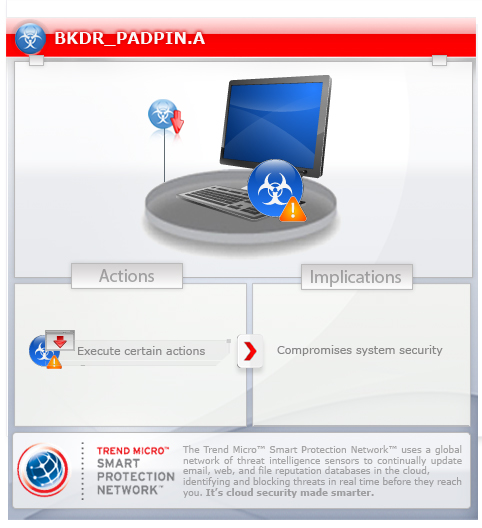BKDR_PADPIN.A
Backdoor.MSIL.Tyupkin.a (Kaspersky), Backdoor.Padpin (Symantec)
Windows 2000, Windows Server 2003, Windows XP (32-bit, 64-bit), Windows Vista (32-bit, 64-bit), Windows 7 (32-bit, 64-bit)


Threat Type: Trojan
Destructiveness: No
Encrypted: Yes
In the wild: Yes
OVERVIEW
This malware was involved in the September 2014 ATM hacking attacks involving Malaysian banks. Systems affected by this malware can be considered compromised, and organizations using these systems may find their finances being affected.
To get a one-glance comprehensive view of the behavior of this Trojan, refer to the Threat Diagram shown below.

This Trojan may be dropped by other malware.
TECHNICAL DETAILS
Arrival Details
This Trojan may be dropped by other malware.
Autostart Technique
This Trojan adds the following registry entries to enable its automatic execution at every system startup:
HKEY_LOCAL_MACHINE\SOFTWARE\Microsoft\
Windows\CurrentVersion\Run
ulssm.exe = "{malware path}\ulssm.exe"
HKEY_CURRENT_USER\Software\Microsoft\
Windows\CurrentVersion\Run
ulssm.exe = "{malware path}\ulssm.exe"
Other Details
This Trojan requires the existence of the following files to properly run:
- XFS
It does the following:
- It may perform any of the following functions:
- Uninstall itself
- Dispense cash from selected ATM cassette
- Show cassette information
- nominal
- items left (number of bills stored)
- total (total amount stored)
- Show cash unit information
- Disable network connection
SOLUTION
Step 1
Before doing any scans, Windows XP, Windows Vista, and Windows 7 users must disable System Restore to allow full scanning of their computers.
Step 2
Restart in Safe Mode
Step 3
Delete this registry value
Important: Editing the Windows Registry incorrectly can lead to irreversible system malfunction. Please do this step only if you know how or you can ask assistance from your system administrator. Else, check this Microsoft article first before modifying your computer's registry.
- In HKEY_LOCAL_MACHINE\SOFTWARE\Microsoft\Windows\CurrentVersion\Run
- ulssm.exe = "{malware path}\ulssm.exe"
- ulssm.exe = "{malware path}\ulssm.exe"
- In HKEY_CURRENT_USER\Software\Microsoft\Windows\CurrentVersion\Run
- ulssm.exe = "{malware path}\ulssm.exe"
- ulssm.exe = "{malware path}\ulssm.exe"
Step 4
Restart in normal mode and scan your computer with your Trend Micro product for files detected as BKDR_PADPIN.A. If the detected files have already been cleaned, deleted, or quarantined by your Trend Micro product, no further step is required. You may opt to simply delete the quarantined files. Please check this Knowledge Base page for more information.
Did this description help? Tell us how we did.


